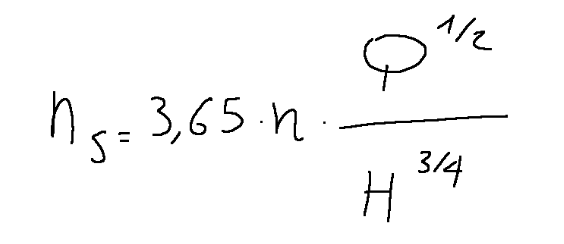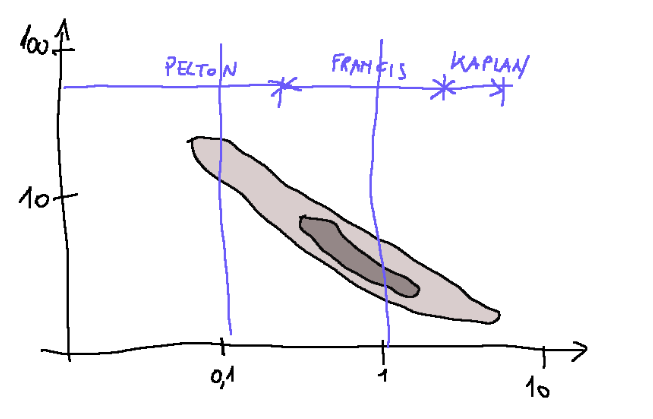27-06-2024 - Energy systems - Choosing a turbine[EN]-[IT]

~~~ La versione in italiano inizia subito dopo la versione in inglese ~~~
ENGLISH
27-06-2024 - Energy systems - Choosing a turbine[EN]-[IT]
Choosing a Turbine
Characteristic speed
The characteristic rpm of a hydraulic turbine is given by the following formula:

Where:
H = geodetic difference in height expressed in metres
Q = volumetric flow rate
NOTE: The geodetic difference in height is the difference in height between the water basin from which the pump draws the fluid and the arrival basin. For example, if a pump sucks water from a certain level of a tank, and brings it up to a level higher than 5 metres, then its head is H = 5 m. This is also called geodetic difference in height.
Specific RPM
For rather high values of geodetic head and low flow rates, the characteristic number of revolutions is limited and the choice may fall on PELTON turbines.
By increasing the flow rate, we must start using reaction turbines. In progression to this increase, first we will need Francis turbines and then we will necessarily have to use propeller and Kaplan turbines.
Operating intervals of useful jump
Below are the operating ranges of the useful head for different types of hydraulic turbines.
High heads: Pelton turbines
Medium heads: Turbine Francis, Turbine Banki (depending on specifications)
Low heads: Kaplan Turbines, Propeller Turbines, Banki Turbines (depending on specifications)
Flow Operating Ranges
Below are the flow rate operating ranges for different types of turbines.
-Low flow rates: Pelton Turbines (up to 50 m³/s), Banki Turbines (up to 20 m³/s)
-Medium flow rates: Francis turbines (1-100 m³/s), Propeller turbines (1-100 m³/s)
-High flow rates: Kaplan turbines (10-700 m³/s)
Power operating ranges
Below are the power operating ranges for different types of turbines
-Low power: Pelton Turbines, Banki Turbines (for small scale applications)
-Medium power: Francis turbines, propeller turbines
-High power: Kaplan turbines
Classification based on characteristic rpm
High-speed pumps have a characteristic speed usually over 1000 rpm.
Medium speed pumps have a characteristic speed typically between 500 and 1000 rpm
Low speed pumps have a characteristic rpm typically less than 500 rpm
Examples:
Regarding the characteristic number of revolutions of Pelton turbines we can say that they generally operate at very high speeds.
Regarding the characteristic number of revolutions of Francis turbines we can say that they usually operate at moderate speeds, typically between 100 and 1000 rpm.
As regards the characteristic number of revolutions of propeller turbines, we can say that they operate at relatively low speeds, starting from a few tens of rpm up to a few hundred rpm.
Baljé diagram
The Baljé diagram is a tool used to analyze the performance of hydraulic turbines and therefore use the one most suitable for the project being developed.
The specific flow coefficient is shown on the x axis, while the total efficiency of the turbine is represented on the y axis.
Below is a sketch of a graphical representation of the Baljé diagram.

Conclusions
The right choice regarding a hydraulic turbine depends not only on the available head and flow rate, but also on the power required for the specific application.
Request
Have you ever heard of one of these hydraulic turbine models, Pelton, Francis or Kaplan?

ITALIAN
27-06-2024 - Sistemi energetici - Scelta di una turbina[EN]-[IT]
Scelta di una turbina
Numero di giri caratteristico
Il numero di giri caratteristico di una turbina idraulica è dato dalla seguente formula:

Dove:
H = dislivello geodetico espresso in metri
Q = portata volumetrica
NOTA: Il dislivello geodetico è il dislivello che c’è tra il bacino d’acqua da cui la pompa pesca il fluido e il bacino d’arrivo. Esempio, se una pompa aspira acqua da un certo livello di un serbatoio, e la porta fino ad un livello più alto di 5 metri, allora la sua prevalenza è di H = 5 m. QUesto è detto anche dislivello geodetico.
Numero di giri specifico
Per valori piuttosto alti di salto geodetico e portate ridotte, il numero di giri caratteristico risulta limitato e la scelta può ricadere su turbine PELTON.
Aumentando la portata si deve iniziare a fare uso di turbine a reazione. In progressione a questo aumento, prima avremo bisogno di turbine Francis e poi dovremmo per forza usare turbine ad elica e Kaplan.
Intervalli operativi del salto utile
Qui di seguito gli intervalli operativi del salto utile per diverse tipologie di turbine idrauliche.
Alti salti: Turbine Pelton
Medi salti: Turbine Francis, Turbine Banki (a seconda delle specifiche)
Bassi salti: Turbine Kaplan, Turbine a elica, Turbine Banki (a seconda delle specifiche)
Intervalli operativi della portata
Qui di seguito gli intervalli operativi della portata per diverse tipologie di turbine.
-Basse portate: Turbine Pelton (fino a 50 m³/s), Turbine Banki (fino a 20 m³/s)
-Medie portate: Turbine Francis (1-100 m³/s), Turbine a elica (1-100 m³/s)
-Alte portate: Turbine Kaplan (10-700 m³/s)
Intervalli operativi della potenza
Qui di seguito gli intervalli operativi della potenza per diverse tipologie di turbine
-Bassa potenza: Turbine Pelton, Turbine Banki (per applicazioni di piccola scala)
-Media potenza: Turbine Francis, Turbine a elica
-Alta potenza: Turbine Kaplan
Classificazione in base al numero di giri caratteristico
Le pompe ad alta velocità hanno un numero di giri caratteristico solitamente oltre 1000 rpm.
Le pompe a media velocità hanno un numero di giri caratteristico tipicamente compreso tra 500 e 1000 rpm
Le pompe a bassa velocità hanno un numero di giri caratteristico tipicamente inferiore ai 500 rpm
Esempi:
Per quanto riguarda il numero di giri caratteristico delle turbine Pelton possiamo dire che generalmente operano a velocità molto elevate.
Per quanto riguarda il numero di giri caratteristico delle turbine Francis possiamo dire che solitamente operano a velocità moderate, tipicamente comprese tra 100 e 1000 rpm.
Per quanto riguarda il numero di giri caratteristico delle turbine ad elica possiamo dire che operano a velocità relativamente basse, a partire da poche decine di rpm fino a qualche centinaio di rpm.
diagramma di Baljé
Il diagramma di Baljé è uno strumento utilizzato per analizzare le prestazioni delle turbine idrauliche e quindi usare quella più adatta al progetto che si sta elaborando.
Sull’asse x viene riportato il coefficiente di portata specifico, sull’asse y si rappresenta il rendimento totale della turbina.
Qui di seguito uno schizzo di una rappresentazione grafica del diagramma di Baljé.

Conclusioni
La scelta giusta per quanto riguarda una turbina idraulica, dipende non solo dalla caduta e dalla portata disponibili, ma anche dalla potenza richiesta per l'applicazione specifica.
Domanda
Avete mai sentito parlare di uno di questi modelli di turbine idrauliche tra, Pelton, Francis o Kaplan?
THE END
Could you also do a solar energy system for a small house?!
Honestly never knew turbines had such specific speed and flow requirements. It's interesting how different designs like Pelton and Francis are tailored for varying water conditions. Choosing one seems to me like a mix of science and art now
It is really necessary that we actually chose a turbine that can help us determine what we want to actually see
Sì, l'ho sentito diverse volte
!discovery 30
This post was shared and voted inside the discord by the curators team of discovery-it
Join our Community and follow our Curation Trail
Discovery-it is also a Witness, vote for us here
Delegate to us for passive income. Check our 80% fee-back Program
The Balije diagram is actually simple
Thanks for teaching us
Purtroppo mai sentite nominare, mi spiace...

Ma buono a sapersi, perchè queste sono le conoscenze tecniche più utili oggi per non restare mai disoccupati.
!PGM
Keep up the good work. 👏
Recognized by Mystic artist Gudasol
You are loved.
Interested to to help music map cXc.world spread more good vibes on Hive?.